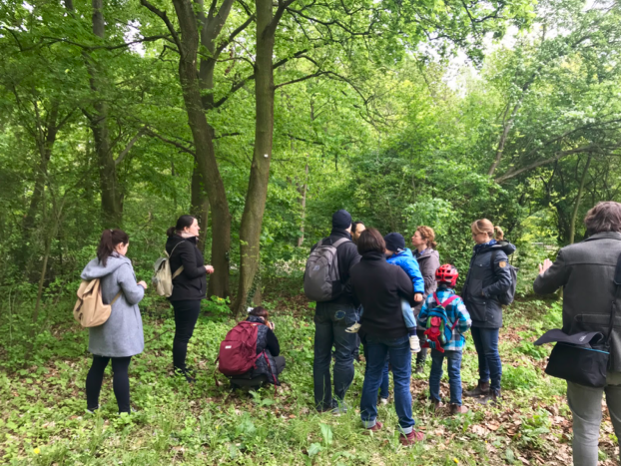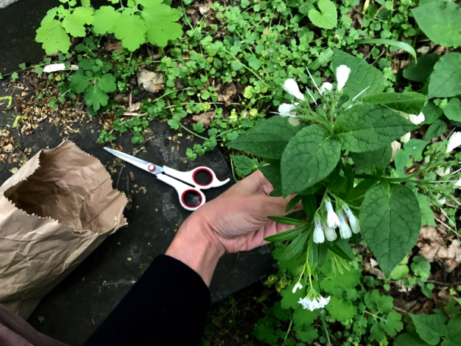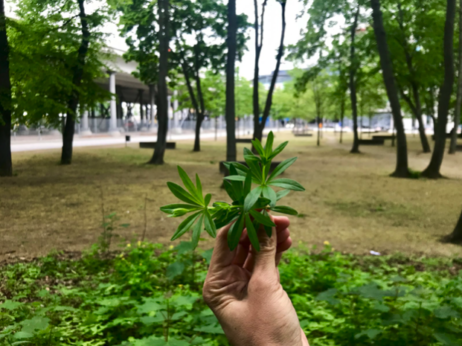Rooted in a History of World War II Refugees, Urban Foraging in Berlin Transcends Trends
Finding Berlin’s wild side in its parks, not its clubs.
Rooted in a History of World War II Refugees, Urban Foraging in Berlin Transcends Trends
Finding Berlin’s wild side in its parks, not its clubs.

City dwellers are surrounded by delicacies such as wild arugula and sea buckthorn.Susannah Edelbaum
From March to May, the leafy corners of Berlin’s larger parks appear to be coated in a thick dark-green grass, which more industrious flâneurs might be seen cutting by the bagful. This is Bärlauch, or bear’s garlic, a wild edible that grows abundantly here and is well loved in pestos, omelettes and truly delicious compound butter. But for many in the know, it’s just one of many comestible and medicinal plants that grow in this verdant city, where 13 percent of the landmass is public green space and another 18 percent is covered by forest. “What’s really important for foragers here is that we’re literally surrounded by wild plants,” explains Jonathan Hamnett, the largely self-taught founder of the one-man tour group Grunewald Foraging. “Wild rocket grows out of the pavement, and we’re surrounded by sea buckthorn.”
Hamnett is a decade-long Berlin resident from Britain who made his way into the foraging tour business in 2014 while working at the nonprofit urban eco-garden Prinzessinnengärten in the middle of trendy Kreuzberg. From spring through fall, he leads English-language groups of neophyte foragers to the edge of the Brandenburg border to hunt for miner’s lettuce, mushrooms and wild herbs. For his own dinner table, he forages throughout the city. Starting with two beautiful mulberry trees, there’s no better place to “train the eye” than the former train depot Schöneberger Südgelände, which is a legacy of this once-divided city, disputed between East and West, says Hamnett. It was subsequently closed to all and largely untouched until 2000, when it was converted into a nature reserve that’s home to 95 types of wild bees and 350 plant species.

Elsewhere, Hamnett won’t reveal the exact location where he reliably finds morels every spring, except to say that it’s a lone wood-chipped flower bed close to his apartment. And the most surprising wild edible he has ever found? Goji berries in winter, along the Berlin canalways, which differ very little in their active compounds from the cultivated species. “To find out that they’re everywhere was pretty startling,” he says, “and nobody ever lets on or talks about it.”
This restraint seems common among the city’s many foragers, though it doesn’t belie illegality. On one hand, German species-protection law generally prohibits the removal of wild plants. On the other hand, the Handstraußregelung, or hand-bouquet regulation, subverts this, permitting small amounts of wildflowers, grasses, ferns, mosses, lichens, fruits, mushrooms, tea herbs, medicinal herbs and wild plant twigs to be taken for personal use from anywhere in nature that isn’t subject to a ban on entry, like your neighbor’s yard. This might explain why baskets spied on the laps of mushroom hunters who return by bus from autumn outings in the city’s Grunewald forest are so small.

Nonetheless, Berlin’s restrained foragers encourage one another, as well as newbies. The Berlin-based organization Mundraub — cheekily, “mouth robbery” — runs an online community-sourced map that lists hundreds of cherry, apple and hazelnut trees and wild herb sites in Berlin alone. For those who aren’t ready for DIY, the group also leads seasonal tours in parks like Plänterwald, better known as the home of Spreepark, a long-abandoned amusement park in East Berlin. Mundraub’s unique data, which pinpoints the city’s wild edibles and medicinals, has proven fruitful in other ways, with one academic paper reporting a notably higher concentration of fruit trees in former East Berlin than in the West. An additional study connects this analysis and the ongoing prevalence of Berlin’s contemporary foraging to the German Democratic Republic’s Sammelstelle, or collection points, where foragers of a very different era could drop off medicinal plants for a bit of extra money.
Mundraub’s painstaking map also makes it easy for committed newcomers to find waldmeister and comfrey in a tiny park behind Berlin’s central station and a hazelnut tree around the corner, but not without reminders all over the organization’s site to take care of, share and tend to wild finds. Even with the most stringent adherence to the hand-bouquet regulation, the city is growing and, paradoxically, its array of wild edibles may fare best with a bit of nurturing. Clearly, evidence that East Berlin needs its fruit trees more than the West and tends to them better is still visible today, and this legacy of care, like foraging itself, persists long past reunification.
Follow us
This work is licensed under a Creative Commons Attribution-NoDerivatives 4.0 International License.
Want to republish a Modern Farmer story?
We are happy for Modern Farmer stories to be shared, and encourage you to republish our articles for your audience. When doing so, we ask that you follow these guidelines:
Please credit us and our writers
For the author byline, please use “Author Name, Modern Farmer.” At the top of our stories, if on the web, please include this text and link: “This story was originally published by Modern Farmer.”
Please make sure to include a link back to either our home page or the article URL.
At the bottom of the story, please include the following text:
“Modern Farmer is a nonprofit initiative dedicated to raising awareness and catalyzing action at the intersection of food, agriculture, and society. Read more at <link>Modern Farmer</link>.”
Use our widget
We’d like to be able to track our stories, so we ask that if you republish our content, you do so using our widget (located on the left hand side of the article). The HTML code has a built-in tracker that tells us the data and domain where the story was published, as well as view counts.
Check the image requirements
It’s your responsibility to confirm you're licensed to republish images in our articles. Some images, such as those from commercial providers, don't allow their images to be republished without permission or payment. Copyright terms are generally listed in the image caption and attribution. You are welcome to omit our images or substitute with your own. Charts and interactive graphics follow the same rules.
Don’t change too much. Or, ask us first.
Articles must be republished in their entirety. It’s okay to change references to time (“today” to “yesterday”) or location (“Iowa City, IA” to “here”). But please keep everything else the same.
If you feel strongly that a more material edit needs to be made, get in touch with us at [email protected]. We’re happy to discuss it with the original author, but we must have prior approval for changes before publication.
Special cases
Extracts. You may run the first few lines or paragraphs of the article and then say: “Read the full article at Modern Farmer” with a link back to the original article.
Quotes. You may quote authors provided you include a link back to the article URL.
Translations. These require writer approval. To inquire about translation of a Modern Farmer article, contact us at [email protected]
Signed consent / copyright release forms. These are not required, provided you are following these guidelines.
Print. Articles can be republished in print under these same rules, with the exception that you do not need to include the links.
Tag us
When sharing the story on social media, please tag us using the following: - Twitter (@ModFarm) - Facebook (@ModernFarmerMedia) - Instagram (@modfarm)
Use our content respectfully
Modern Farmer is a nonprofit and as such we share our content for free and in good faith in order to reach new audiences. Respectfully,
No selling ads against our stories. It’s okay to put our stories on pages with ads.
Don’t republish our material wholesale, or automatically; you need to select stories to be republished individually.
You have no rights to sell, license, syndicate, or otherwise represent yourself as the authorized owner of our material to any third parties. This means that you cannot actively publish or submit our work for syndication to third party platforms or apps like Apple News or Google News. We understand that publishers cannot fully control when certain third parties automatically summarize or crawl content from publishers’ own sites.
Keep in touch
We want to hear from you if you love Modern Farmer content, have a collaboration idea, or anything else to share. As a nonprofit outlet, we work in service of our community and are always open to comments, feedback, and ideas. Contact us at [email protected].by Susannah Edelbaum, Modern Farmer
May 28, 2019
Modern Farmer Weekly
Solutions Hub
Innovations, ideas and inspiration. Actionable solutions for a resilient food system.
ExploreExplore other topics
Share With Us
We want to hear from Modern Farmer readers who have thoughtful commentary, actionable solutions, or helpful ideas to share.
SubmitNecessary cookies are absolutely essential for the website to function properly. This category only includes cookies that ensures basic functionalities and security features of the website. These cookies do not store any personal information.
Any cookies that may not be particularly necessary for the website to function and are used specifically to collect user personal data via analytics, ads, other embedded contents are termed as non-necessary cookies.
Want my mailing address